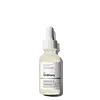What's inside
What's inside
 Key Ingredients
Key Ingredients

 Benefits
Benefits

 Ingredients Side-by-side
Ingredients Side-by-side

Water
Skin ConditioningPropanediol
SolventButylene Glycol
HumectantSodium Hyaluronate
HumectantMorus Alba Root Extract
BleachingSilk Extract
Skin ConditioningYeast Ferment Extract
Skin ConditioningGlycerin
HumectantCamellia Sinensis Leaf Extract
AntimicrobialChamomilla Recutita Flower Extract
MaskingGlycyrrhiza Glabra Root Extract
BleachingRosmarinus Officinalis Leaf Extract
AntimicrobialScutellaria Baicalensis Root Extract
AstringentCentella Asiatica Extract
CleansingPortulaca Oleracea Extract
Skin ConditioningPolygonum Cuspidatum Root Extract
AntioxidantBeta-Glucan
Skin ConditioningOpuntia Ficus-Indica Extract
Skin ConditioningHexylene Glycol
EmulsifyingXanthan Gum
EmulsifyingDipropylene Glycol
HumectantEthylhexylglycerin
Skin Conditioning1,2-Hexanediol
Skin ConditioningHydroxyacetophenone
AntioxidantPotassium Sorbate
PreservativeSodium Hydroxide
BufferingPhenoxyethanol
PreservativeWater, Propanediol, Butylene Glycol, Sodium Hyaluronate, Morus Alba Root Extract, Silk Extract, Yeast Ferment Extract, Glycerin, Camellia Sinensis Leaf Extract, Chamomilla Recutita Flower Extract, Glycyrrhiza Glabra Root Extract, Rosmarinus Officinalis Leaf Extract, Scutellaria Baicalensis Root Extract, Centella Asiatica Extract, Portulaca Oleracea Extract, Polygonum Cuspidatum Root Extract, Beta-Glucan, Opuntia Ficus-Indica Extract, Hexylene Glycol, Xanthan Gum, Dipropylene Glycol, Ethylhexylglycerin, 1,2-Hexanediol, Hydroxyacetophenone, Potassium Sorbate, Sodium Hydroxide, Phenoxyethanol
Water
Skin ConditioningSodium Hyaluronate
HumectantPropanediol
SolventPentylene Glycol
Skin ConditioningHydrolyzed Hyaluronic Acid
HumectantSodium Hyaluronate Crosspolymer
HumectantPhospholipids
Skin ConditioningSphingolipids
EmollientPanthenol
Skin ConditioningAhnfeltiopsis Concinna Extract
Skin ConditioningGlycerin
HumectantPolysorbate 20
EmulsifyingCitric Acid
BufferingSodium Citrate
BufferingP-Anisic Acid
MaskingTocopherol
AntioxidantTrisodium Ethylenediamine Disuccinate
Caprylyl Glycol
EmollientEthoxydiglycol
HumectantEthylhexylglycerin
Skin ConditioningHexylene Glycol
EmulsifyingPhenoxyethanol
PreservativeChlorphenesin
AntimicrobialWater, Sodium Hyaluronate, Propanediol, Pentylene Glycol, Hydrolyzed Hyaluronic Acid, Sodium Hyaluronate Crosspolymer, Phospholipids, Sphingolipids, Panthenol, Ahnfeltiopsis Concinna Extract, Glycerin, Polysorbate 20, Citric Acid, Sodium Citrate, P-Anisic Acid, Tocopherol, Trisodium Ethylenediamine Disuccinate, Caprylyl Glycol, Ethoxydiglycol, Ethylhexylglycerin, Hexylene Glycol, Phenoxyethanol, Chlorphenesin
 Reviews
Reviews

Ingredients Explained
These ingredients are found in both products.
Ingredients higher up in an ingredient list are typically present in a larger amount.
Ethylhexylglycerin (we can't pronounce this either) is commonly used as a preservative and skin softener. It is derived from glyceryl.
You might see Ethylhexylglycerin often paired with other preservatives such as phenoxyethanol. Ethylhexylglycerin has been found to increase the effectiveness of these other preservatives.
Glycerin is already naturally found in your skin. It helps moisturize and protect your skin.
A study from 2016 found glycerin to be more effective as a humectant than AHAs and hyaluronic acid.
As a humectant, it helps the skin stay hydrated by pulling moisture to your skin. The low molecular weight of glycerin allows it to pull moisture into the deeper layers of your skin.
Hydrated skin improves your skin barrier; Your skin barrier helps protect against irritants and bacteria.
Glycerin has also been found to have antimicrobial and antiviral properties. Due to these properties, glycerin is often used in wound and burn treatments.
In cosmetics, glycerin is usually derived from plants such as soybean or palm. However, it can also be sourced from animals, such as tallow or animal fat.
This ingredient is organic, colorless, odorless, and non-toxic.
Glycerin is the name for this ingredient in American English. British English uses Glycerol/Glycerine.
Learn more about GlycerinHexylene Glycol is a surfactant. Glycols are a class of alcohols. Hexylene Glycol is a surfactant and emulsifier.
As a surfactant, Hexylene Glycol helps gather dirt and oil on your skin to be washed away.
As an emulsifier, Hexylene Glycol helps keep water and oil together. This prevents them from separating in a product. Hexylene Glycol also thins out the texture of a product by lessening viscosity.
Hexylene Glycol has a small molecular weight.
Learn more about Hexylene GlycolPhenoxyethanol is a preservative that has germicide, antimicrobial, and aromatic properties. Studies show that phenoxyethanol can prevent microbial growth. By itself, it has a scent that is similar to that of a rose.
It's often used in formulations along with Caprylyl Glycol to preserve the shelf life of products.
Propanediol is an all-star ingredient. It softens, hydrates, and smooths the skin.
It’s often used to:
Propanediol is not likely to cause sensitivity and considered safe to use. It is derived from corn or petroleum with a clear color and no scent.
Learn more about PropanediolSodium Hyaluronate is hyaluronic acid's salt form. It is commonly derived from the sodium salt of hyaluronic acid.
Like hyaluronic acid, it is great at holding water and acts as a humectant. This makes it a great skin hydrating ingredient.
Sodium Hyaluronate is naturally occurring in our bodies and is mostly found in eye fluid and joints.
These are some other common types of Hyaluronic Acid:
Learn more about Sodium HyaluronateWater. It's the most common cosmetic ingredient of all. You'll usually see it at the top of ingredient lists, meaning that it makes up the largest part of the product.
So why is it so popular? Water most often acts as a solvent - this means that it helps dissolve other ingredients into the formulation.
You'll also recognize water as that liquid we all need to stay alive. If you see this, drink a glass of water. Stay hydrated!
Learn more about Water